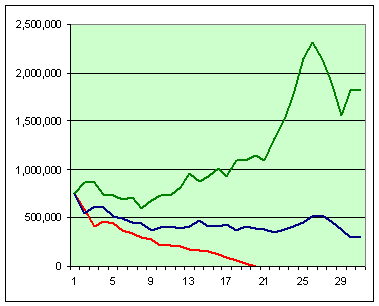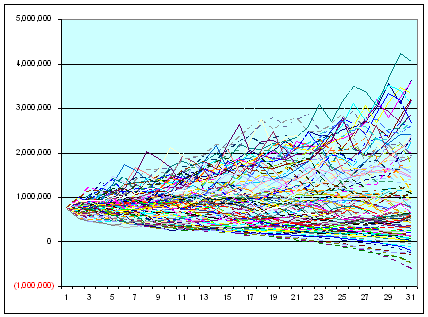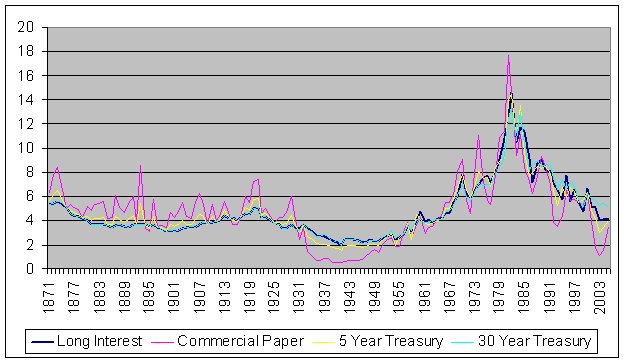Why another retirement calculator?
What could be simpler? You invest and earn an average of x%, and you draw out about the same amount, or perhaps slightly less, and all is well, right? That's what most retirement calculators would have you believe.
Unfortunately, it just ain't so. Taking money out of the portfolio when the market is down depletes the future earning power of the portfolio, potentially to the point where it cannot recover.
A "real numbers" example
Bill, Betty, and Bob retired in 1973, 1974, and 1975, respectively. Each had $750,000 in their nest egg, split 75% in a stock index fund and 25% in a bond index fund. Each took a withdrawal of January 1 every year of $35,000 (adjusted for inflation). For this example, none had Social Security or a pension.
 Nineteen
years into retirement, Bill was broke. He couldn't even take his full $35,000
to live on that year. In a panic, Betty and Bob checked their balances. Betty
had about half what she started with, and Bob had over double what he started
with! By the end of the 30 years they had planned for, Betty was down to about
$300,000, and Bob was still sitting with double his starting portfolio, despite
having taken a half million dollar loss in the previous few years. Bill, of
course, had long ago taken a job passing out shopping carts at a large discount
store to make ends meet.
Nineteen
years into retirement, Bill was broke. He couldn't even take his full $35,000
to live on that year. In a panic, Betty and Bob checked their balances. Betty
had about half what she started with, and Bob had over double what he started
with! By the end of the 30 years they had planned for, Betty was down to about
$300,000, and Bob was still sitting with double his starting portfolio, despite
having taken a half million dollar loss in the previous few years. Bill, of
course, had long ago taken a job passing out shopping carts at a large discount
store to make ends meet.
These examples use real numbers, real inflation, and real market performance for those years. All three started with exactly the same portfolio and took the same inflation-adjusted withdrawals.
The killer was volatility. The inevitable ups and downs in the market.
Bob, the lucky one, actually had only average performance for a 30 year span, given the investment choices for this portfolio. He was lucky because he caught a bull market his first few years into retirement. Betty got clobbered by a down market early on, but survived, while Bill just never could recover from the initial bear market. The annual withdrawals consumed a larger and larger percentage of his dwindling portfolio, leaving nothing to grow.
So you can't just expect to make 10% and take out 9.5% every year. You need to withdraw at a more conservative rate, so that you don't destroy the earning power of your portfolio when you draw living expenses out following rough years in the market.
 How can FIRECalc help?
How can FIRECalc help?
We can't all just decide to be lucky like Bob. But we can determine what we'll need to have set aside to avoid winding up like Bill. That's what FIRECalc is for.
FIRECalc factors in the historical volatility in the market, so you can see whether your financial plan is robust enough to stand up to the worst we've seen in the history of the stock market.
FIRECalc scores "100% safe" a financial plan that would have survived the Great Depression, and every other financial calamity we've encountered.
FIRECalc answers these questions ...
If you tell FIRECalc how much you have, and how much you'll be taking out each year, FIRECalc will show you how such a combination would have fared for the duration of your retirement, in every year for which we have market data.
 You can tell FIRECalc how "safe" you want to be, and how much
you have, and it will tell you how much you can plan to spend. Or you can
tell FIRECalc how much you want to spend, and it will tell you how much you'll need in your portfolio.
You can tell FIRECalc how "safe" you want to be, and how much
you have, and it will tell you how much you can plan to spend. Or you can
tell FIRECalc how much you want to spend, and it will tell you how much you'll need in your portfolio.
FIRECalc will also display the impact of different allocations between equities and fixed income investments, the effects of investment expenses, and the financial implications of accelerating or delaying your retirement.
If you choose, you can factor in your future Social Security payments, modifications to your withdrawals for pensions or other changes, future lump sum changes to your portfolio, and other options.
But recognize limits to fine tuning
It's awfully tempting to try to tweak settings to get the results you want. But keep in mind that a tool like FIRECalc is intended to help you see if your plan pushes too close to the edge, decades from now. You can try 1001 different combinations of investments and timings to see what happens, but don't fall into the trap of measuring something with a micrometer when you'll be cutting it with an axe.
Frequently Asked Questions
 The following are some of the questions that have come up in our forum and
by email. You will also find a good ongoing discussion of these issues and
related in the Early Retirement
forum.
The following are some of the questions that have come up in our forum and
by email. You will also find a good ongoing discussion of these issues and
related in the Early Retirement
forum.
How does FIRECalc work?
As Jonathan Clements in The Wall Street Journal put it, FIRECalc "analyzes what would have happened if you retired in 1871, in 1872, in 1873 and so on. It then calculates how often your strategy would have panned out historically."
What does the answer tell me?
If you get a "100% success rate" with what you have and what you plan to spend, this means that you would have been able to maintain your standard of living and not run out of money, despite the worst that we've ever seen, including the Great Depression. A lesser success rate helps you assess the risk of retiring with what you have and what you plan to spend.
|
FIRECalc answers... "With what I have today, and what it costs me to live, can I retire and maintain the same lifestyle?" |
How can I be sure these results will work in the future?
FIRECalc's standard model uses the overall US stock market performance. Most 401k and similar retirement plans offer investment choices ("index funds") that are closely tied to the overall market performance, and the others generally tell you how they compare.
If the next few decades are even worse for the stock market than the worst that has ever been seen, including the Great Depression, then all bets are off.
But as one early retiree pointed out, there isn't much anyone can do to prepare for a comet hitting us!
How can FIRECalc predict future returns from past performance?
It can't. And it doesn't try. In fact, it tries to predict what will not happen. This might sound confusing, but it's really simple.
Consider an analogy: Suppose you are building a house in Honolulu. How do you decide how much heating and air conditioning capacity you will need?
We know that the lowest it has ever been there was 52°, on a day in February 1902 and again on another day in January 1969, and the hottest it has ever been was 95°, in 1994. Buying a system suitable for an Anchorage-style winter and a Phoenix-style summer would be a major waste of money that could be better used elsewhere.
FIRECalc works the same way, using stock market history and your portfolio and spending plan instead of weather history and furnace capacity. No one could predict the temperature for any specific given future date during the decades that house will be used, and no one can predict the future returns of your investments. But by knowing the historical worst cases, you'll have the information to judge if your savings are sufficient to handle the winter.
What if my investments aren't in the stock market?
If your investments are in something that doesn't track closely with the US stock market, such as real estate for example, then you can still use FIRECalc, but since there is no way for FIRECalc to know how your investments performed in the past, you'll need to enter your own performance figures.
I read somewhere about a "4% rule." Does FIRECalc use that?
The "4% Rule" is shorthand for a lot of research by a lot of different people that finds, in general, long term withdrawals are sustainable if they are roughly 4% of the portfolio, when there are no other sources of funds (Social Security, etc.) and no variations in the spending throughout the retirement. FIRECalc finds similar results.
Is that 4% of the starting portfolio, or 4% of the value at the time the money is withdrawn?
It will do either. FIRECalc seeks to answer the question, "With what I have today, and what it costs me to live, can I retire and maintain the same lifestyle?" So it works with today's portfolio. Since your lifestyle costs will change with inflation, the future withdrawals are adjusted accordingly, and FIRECalc tells you how often such a withdrawal plan would have worked.
But planning is different than practice. In Work Less, Live More, author Bob Clyatt points out that most people will adjust their spending in response to the value of their nest egg. If you choose, FIRECalc will base withdrawals on the portfolio value at the time of each annual withdrawal, instead of the starting portfolio.
How about describing FIRECalc step by step?
Sure. FIRECalc offers you the opportunity to change the calculations, to introduce new financial events, to change expected market conditions, and more. But the standard functionality is as follows:
-
First, FIRECalc models a retirement year
- FIRECalc starts with your nest egg, and takes out the amount of money you said you need to live on (after calculating how inflation would have affected your cost of living for that year).
- Then, FIRECalc computes what would have happened to the remainder of your portfolio for that year, with market growth, dividends, investment expenses, and interest on your fixed income investments.
-
Then FIRECalc models a retirement cycle
- FIRECalc starts with a particular year and calculates your retirement year results, as though you had retired that year. Then it takes those results and applies them to the following year, using the actual market conditions for that second year. Then it takes those results and applies them to the next. And so forth, for as many years as you said you wanted your retirement to last.
 This "retirement cycle" in FIRECalc is a full term retirement starting in
an arbitrary year, but using the actual conditions for the years in the
cycle. The cycle succeeded if the portfolio remained "in
the black" for the entire term, and it failed if it was depleted before
the end.
This "retirement cycle" in FIRECalc is a full term retirement starting in
an arbitrary year, but using the actual conditions for the years in the
cycle. The cycle succeeded if the portfolio remained "in
the black" for the entire term, and it failed if it was depleted before
the end.- In the chart on the right and on the results page, each line represents one cycle.
-
Finally, FIRECalc generates its final results
- FIRECalc starts with a retirement cycle beginning in 1871 and determines whether that cycle would have succeeded (remained in the black) or not. Then it starts over, with a cycle starting in 1872. Then 1873, and so forth until the most recent year for which there are results available.
- Finally, FIRECalc reports numerically and graphically how often your retirement plan would have worked. If there were 106 possible cycles, and 6 of them failed, then FIRECalc will report 94.3% success.
 Where did the idea behind FIRECalc come from?
Where did the idea behind FIRECalc come from?
In 1997, Trinity University professors Philip Cooley, Carl Hubbard, and Daniel Walz published a study entitled The Trinity Study: Annual Withdrawal Rates and Portfolio Success. While other studies had looked at long term survival of various specific investments, this study was the first widely disseminated research showing that retirees whose annual spending was more than around 4% of their starting portfolio would outlive their nest eggs, regardless of how they invested.
John Greaney, who hosts the Retire Early Home Page website created a spreadsheet to illustrate these effects. His site and spreadsheet, and an associated forum he hosted at The Motley Fool's website, brought the concept to a lot of people who had not considered it before, including FIRECalc's author.
That spreadsheet was the inspiration and model for the original FIRECalc, which was developed to add the ability to schedule changes to future withdrawals (such as might be made when the retiree becomes eligible for Social Security or a pension), to iteratively find a solution for a desired success rate, etc. FIRECalc wasn't a "conversion" of that spreadsheet, but certainly followed the same approach to the issue.
A large number of the enhancements to the basic functionality of FIRECalc were suggested by members of the Early Retirement Forum, many of whom helped test the program as it was being updated.
There are a number of other studies and calculators that explore the same effects. All will vary in some details, since each developer may have different ideas about such matters as how much of each year's inflation will affect that year's spending, and whether the funds withdrawn for the year's spending will continue to earn interest. But all of the studies converge on the same basic results.
Those with a mathematical bent can find endless fascination in these effects, but unless you just enjoy the math, keep in mind that when the issue is how close to the edge one can get over the 30-50 years of a retirement, the mathematician might measure with a micrometer, but the retiree will be cutting with an axe.
Please clarify this idea of some cycles succeeding and some failing.
To perhaps make this more clear, look at the chart above. The lines show the year-by-year portfolio balances for all the 30 year retirement cycles calculated by a typical FIRECalc run — each line is a separate cycle. As you can see, in most cases, the portfolio winds up not too far from where it started, despite the retiree's withdrawal of 4.3% each year (with inflation adjustments) for 30 years. In some cases, the ending portfolio was many times the starting portfolio. But there were also a handful of cases in which the retiree went broke before the planned 30 year term.
If we adjusted the starting amount or the annual withdrawals just enough to make sure that lowest line stays above zero the entire 30 years, we'd call that a "100% success rate."
This is the essence of FIRECalc and the idea of "safe withdrawal rates" — seeking a strategy that would have the worst results right up to the edge of failure, without going over.
I am not sure that my entries are doing what they should. How can I check?
One way is to start with a nearly blank scenario with zero expenses, zero inflation, and zero growth. Make a single change at a time and see the effect on the timeline. Remove that change and make another. Keep doing this until you satisfy yourself that your changes are happening as you expect.
I am baffled by the average ending portfolio balance amounts. Why would one want that much remaining?
Look at the chart again. Some of the lines end at over 6 times the starting point, and these drive the average up to a little over $1 million. But some end well below zero.
Since the calculator is designed to help avoid depleting the nest egg, users will normally fiddle with the withdrawals and so forth until few if any lines hit zero -- but given the variability of possible outcomes, that will push the AVERAGE end point way up there. The reason the calculator was designed this way is that folks thinking of retiring early have to potentially face 30, 40, or more years of uncertain market returns, while a "normal" retiree might only face an average of 10 - 15 years.
In practice, if things are going really well with the market in the early years (the situation that results in the highest ending balances), most folks will readjust and spend more.
 There are several choices of fixed income investments.
How do they compare?
There are several choices of fixed income investments.
How do they compare?
The long interest rate (default) is probably closer to typical fixed income investments than commercial paper, which is less stable and not often used as an investment by individuals. Five and 30 year Treasuries are offered for additional research.
Note: the 5 year Treasury investments have only been available since 1953. Data from 1871 through 1952 is simulated using the long interest rate and commercial paper rate. The 30 year Treasuries started in 1925. Prior years used the long interest rate. Look at the graph to see their relationships.
Does the model assume annual rebalancing?
Yes, it assumes you maintain the same ratio between equities and fixed income investments by rebalancing at the time of each annual withdrawal.
Why don't you have a space for taxable portfolio and another space for nontaxable portfolio?
FIRECalc ignores taxable versus nontaxable portfolios right now. Since it only uses historical data to determine how a portfolio would behave, with no guesses by anyone about what will happen to inflation, market performance, and so forth, and we don't have historical tax rates for the period for which I have market data, I can't add tax planning without changing the philosophy of the program. Just planning on x% tax rates would make all the historical examples meaningless, when changing tax rates would have at least some effect on the market returns.
If I can figure out how to do this in a way that would not corrupt the results, I'll do it. For now, I prefer to leave the tax planning portion to programs like www.i-orp.com -- an outstanding tool!
Can I include my antique car and collection of Elvis LPs in the value of my portfolio?
Not unless you make the assumption that these assets will behave the same way as the stock market in general, and can be used to pay for your groceries when necessary. The results come from looking at stock market behavior, fixed income rates, and inflation -- research on other assets has not been included in these studies.
How about my paid-off house?
You are probably better off treating it outside the FIRECalc model, perhaps as an emergency source of funds should you need to tap the equity. But it's value already shows up in FIRECalc, in the form of reduced annual spending. If you had to increase your annual spending by $20,000 or so to cover mortgage costs, your required portfolio would increase by roughly $500,000.
So your paid-off house already acts as a valuable part of your plan. Entering it's cash value would double-count it and give you misleading results, since if you were to sell or mortgage it to free up cash, you would also begin to incur new expenses for rent or debt payments.